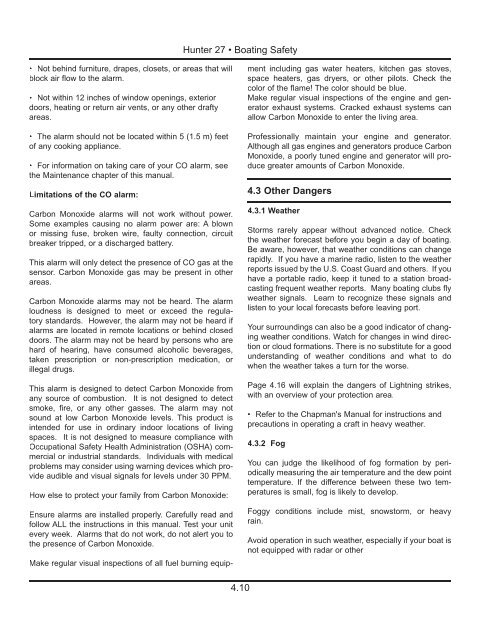27 Operator's Manual.. - Marlow-Hunter, LLC
27 Operator's Manual.. - Marlow-Hunter, LLC
27 Operator's Manual.. - Marlow-Hunter, LLC
Create successful ePaper yourself
Turn your PDF publications into a flip-book with our unique Google optimized e-Paper software.
<strong>Hunter</strong> <strong>27</strong> • Boating Safety<br />
• Not behind furniture, drapes, closets, or areas that will<br />
block air flow to the alarm.<br />
• Not within 12 inches of window openings, exterior<br />
doors, heating or return air vents, or any other drafty<br />
areas.<br />
• The alarm should not be located within 5 (1.5 m) feet<br />
of any cooking appliance.<br />
• For information on taking care of your CO alarm, see<br />
the Maintenance chapter of this manual.<br />
Limitations of the CO alarm:<br />
Carbon Monoxide alarms will not work without power.<br />
Some examples causing no alarm power are: A blown<br />
or missing fuse, broken wire, faulty connection, circuit<br />
breaker tripped, or a discharged battery.<br />
This alarm will only detect the presence of CO gas at the<br />
sensor. Carbon Monoxide gas may be present in other<br />
areas.<br />
Carbon Monoxide alarms may not be heard. The alarm<br />
loudness is designed to meet or exceed the regulatory<br />
standards. However, the alarm may not be heard if<br />
alarms are located in remote locations or behind closed<br />
doors. The alarm may not be heard by persons who are<br />
hard of hearing, have consumed alcoholic beverages,<br />
taken prescription or non-prescription medication, or<br />
illegal drugs.<br />
This alarm is designed to detect Carbon Monoxide from<br />
any source of combustion. It is not designed to detect<br />
smoke, fire, or any other gasses. The alarm may not<br />
sound at low Carbon Monoxide levels. This product is<br />
intended for use in ordinary indoor locations of living<br />
spaces. It is not designed to measure compliance with<br />
Occupational Safety Health Administration (OSHA) commercial<br />
or industrial standards. Individuals with medical<br />
problems may consider using warning devices which provide<br />
audible and visual signals for levels under 30 PPM.<br />
How else to protect your family from Carbon Monoxide:<br />
Ensure alarms are installed properly. Carefully read and<br />
follow ALL the instructions in this manual. Test your unit<br />
every week. Alarms that do not work, do not alert you to<br />
the presence of Carbon Monoxide.<br />
Make regular visual inspections of all fuel burning equip-<br />
ment including gas water heaters, kitchen gas stoves,<br />
space heaters, gas dryers, or other pilots. Check the<br />
color of the flame! The color should be blue.<br />
Make regular visual inspections of the engine and generator<br />
exhaust systems. Cracked exhaust systems can<br />
allow Carbon Monoxide to enter the living area.<br />
Professionally maintain your engine and generator.<br />
Although all gas engines and generators produce Carbon<br />
Monoxide, a poorly tuned engine and generator will produce<br />
greater amounts of Carbon Monoxide.<br />
4.3 Other Dangers<br />
4.3.1 Weather<br />
Storms rarely appear without advanced notice. Check<br />
the weather forecast before you begin a day of boating.<br />
Be aware, however, that weather conditions can change<br />
rapidly. If you have a marine radio, listen to the weather<br />
reports issued by the U.S. Coast Guard and others. If you<br />
have a portable radio, keep it tuned to a station broadcasting<br />
frequent weather reports. Many boating clubs fly<br />
weather signals. Learn to recognize these signals and<br />
listen to your local forecasts before leaving port.<br />
Your surroundings can also be a good indicator of changing<br />
weather conditions. Watch for changes in wind direction<br />
or cloud formations. There is no substitute for a good<br />
understanding of weather conditions and what to do<br />
when the weather takes a turn for the worse.<br />
Page 4.16 will explain the dangers of Lightning strikes,<br />
with an overview of your protection area.<br />
• Refer to the Chapman's <strong>Manual</strong> for instructions and<br />
precautions in operating a craft in heavy weather.<br />
4.3.2 Fog<br />
You can judge the likelihood of fog formation by periodically<br />
measuring the air temperature and the dew point<br />
temperature. If the difference between these two temperatures<br />
is small, fog is likely to develop.<br />
Foggy conditions include mist, snowstorm, or heavy<br />
rain.<br />
Avoid operation in such weather, especially if your boat is<br />
not equipped with radar or other<br />
4.10

















